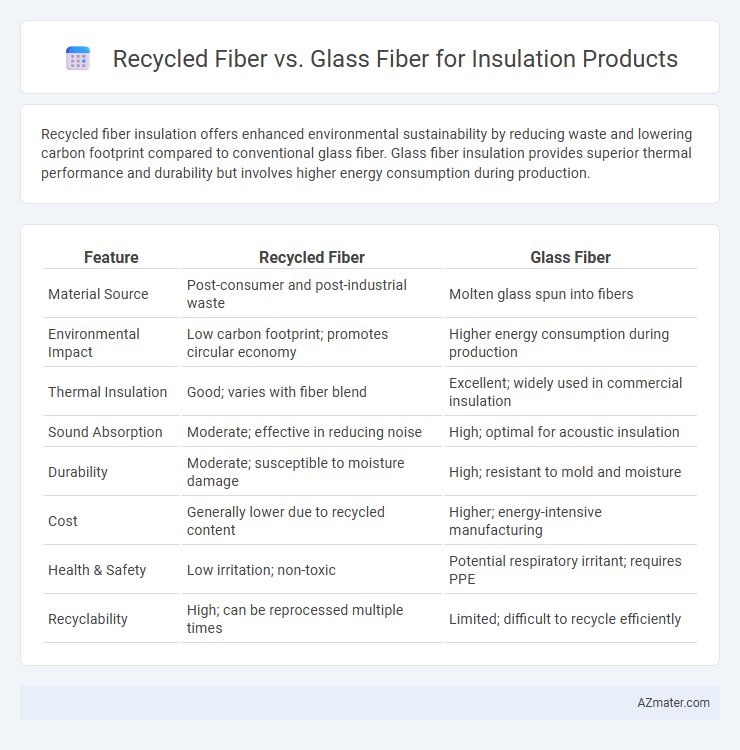Recycled fiber insulation offers enhanced environmental sustainability by reducing waste and lowering carbon footprint compared to conventional glass fiber. Glass fiber insulation provides superior thermal performance and durability but involves higher energy consumption during production.
Table of Comparison
| Feature | Recycled Fiber | Glass Fiber |
|---|---|---|
| Material Source | Post-consumer and post-industrial waste | Molten glass spun into fibers |
| Environmental Impact | Low carbon footprint; promotes circular economy | Higher energy consumption during production |
| Thermal Insulation | Good; varies with fiber blend | Excellent; widely used in commercial insulation |
| Sound Absorption | Moderate; effective in reducing noise | High; optimal for acoustic insulation |
| Durability | Moderate; susceptible to moisture damage | High; resistant to mold and moisture |
| Cost | Generally lower due to recycled content | Higher; energy-intensive manufacturing |
| Health & Safety | Low irritation; non-toxic | Potential respiratory irritant; requires PPE |
| Recyclability | High; can be reprocessed multiple times | Limited; difficult to recycle efficiently |
Introduction to Insulation Materials
Recycled fiber insulation, made from repurposed cellulose or denim, offers superior eco-friendliness and excellent thermal performance by reducing landfill waste. Glass fiber insulation, composed of fine glass strands, delivers high durability, fire resistance, and cost-effective thermal and acoustic insulation. Both materials are key choices in sustainable building, with recycled fiber prioritizing environmental impact and glass fiber emphasizing long-term resilience and safety.
Understanding Recycled Fiber Insulation
Recycled fiber insulation, made primarily from reclaimed cellulose or denim fibers, offers an eco-friendly alternative to traditional glass fiber insulation by reducing landfill waste and conserving natural resources. These materials provide superior thermal performance and sound absorption due to their dense, porous structure, enhancing energy efficiency and indoor comfort. Unlike glass fiber, recycled fiber insulation produces less irritation during installation, making it safer for installers and reducing the need for protective gear.
Overview of Glass Fiber Insulation
Glass fiber insulation consists of fine strands of glass woven into a fibrous mat that effectively traps air to reduce heat transfer and improve energy efficiency. It is widely utilized in residential and commercial buildings due to its high thermal resistance (R-value), fire retardancy, and moisture resistance, ensuring long-term durability and performance. Compared to recycled fiber alternatives, glass fiber insulation offers superior soundproofing and structural strength, making it a preferred choice for various climate conditions.
Thermal Performance Comparison
Recycled fiber insulation typically offers superior thermal performance due to its higher density and better air-trapping capabilities, resulting in enhanced R-values compared to glass fiber. Glass fiber insulation, while effective, often has lower thermal resistance because of its lower density and greater susceptibility to air leakage. Studies indicate recycled fibers can reduce heat transfer more efficiently, making them a preferred choice for energy-saving insulation solutions.
Environmental Impact and Sustainability
Recycled fiber insulation products significantly reduce environmental impact by utilizing post-consumer waste, lowering landfill contributions, and conserving raw materials compared to glass fiber insulation. Glass fiber production involves high energy consumption and emits considerable greenhouse gases, whereas recycled fiber manufacturing typically requires less energy and promotes circular economy principles. Sustainable insulation choices prioritize recycled fibers for minimizing carbon footprint, enhancing resource efficiency, and supporting long-term ecological balance.
Cost Effectiveness and Availability
Recycled fiber insulation offers significant cost effectiveness due to lower raw material expenses and reduced energy consumption during production, making it a budget-friendly choice for eco-conscious projects. Glass fiber insulation, while slightly higher in cost, benefits from widespread availability and consistent manufacturing standards, ensuring reliable supply and performance across regions. Both materials support sustainable construction, but recycled fibers excel in affordability, whereas glass fibers dominate in market accessibility and long-term durability.
Installation and Handling Differences
Recycled fiber insulation offers greater flexibility and ease of handling compared to glass fiber, reducing the risk of skin irritation and simplifying installation in tight spaces. Glass fiber requires protective gear due to its potential to cause itching and respiratory discomfort, often extending installation time and complexity. Additionally, recycled fiber's lighter weight enhances maneuverability, making it preferable for projects with frequent adjustments or complex geometries.
Health and Safety Considerations
Recycled fiber insulation offers superior health safety due to its non-toxic, formaldehyde-free composition, reducing respiratory irritation and allergy risks common with glass fiber materials. Glass fiber insulation can release airborne fibers that cause skin, eye, and lung irritation, necessitating protective equipment during installation and potential ventilation requirements. Choosing recycled fiber enhances indoor air quality and minimizes occupational hazards, making it a safer long-term solution for residential and commercial insulation projects.
Durability and Lifespan
Recycled fiber insulation offers moderate durability with resistance to moisture and pests but generally has a shorter lifespan compared to glass fiber. Glass fiber insulation is highly durable, maintaining structural integrity and thermal performance for up to 50 years or more under optimal conditions. Its resistance to mold, fire, and moisture contributes to a superior lifespan and long-term cost efficiency in insulation applications.
Which Insulation is Best for Your Project?
Recycled fiber insulation offers exceptional sustainability benefits with high thermal performance and excellent sound absorption, making it ideal for eco-conscious projects. Glass fiber insulation provides superior fire resistance and moisture resistance, ensuring durability and long-term efficiency in various climate conditions. Choosing between recycled fiber and glass fiber depends on your project's environmental goals, required R-values, and exposure to moisture or fire hazards.

Infographic: Recycled fiber vs Glass fiber for Insulation product
 azmater.com
azmater.com